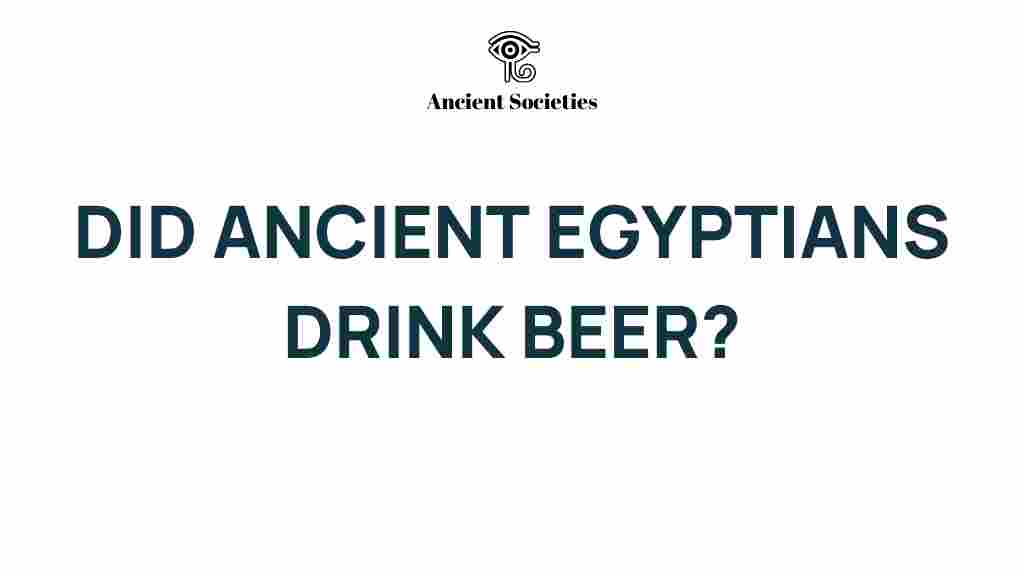Did Ancient Egyptians Really Quench Their Thirst with Beer?
When we think of Ancient Egyptians, images of towering pyramids, majestic pharaohs, and intricate hieroglyphs often come to mind. However, a less glamorous yet equally fascinating aspect of their daily life is their beer consumption. The role of beer in Ancient Egyptian society is a reflection of their cultural practices, social customs, and daily routines. This article delves into the archaeological evidence and historical beverages that illustrate how beer was more than just a drink; it was a vital part of life in ancient Egypt.
The Significance of Beer in Ancient Egyptian Daily Life
Beer was a staple in the diet of the Ancient Egyptians, consumed by people of all ages and social classes. It served various purposes, from nourishment to ritualistic functions. Here are some key points about its significance:
- Nutritional Value: Beer was a source of calories and nutrients, which were essential in the often harsh living conditions of the Nile Valley.
- Social Beverage: Beer was commonly consumed during social gatherings and festivities, promoting camaraderie among individuals.
- Ritual Uses: In religious ceremonies, beer was offered to deities, emphasizing its sacred status in Ancient Egyptian culture.
Archaeological Findings: The Evidence of Beer in Ancient Egypt
The archaeological record provides compelling evidence of the importance of beer in Ancient Egyptian life. Excavations of ancient breweries and findings of beer jars have revealed much about their fermentation techniques and consumption practices.
- Breweries: Archaeologists have discovered large-scale breweries in sites like Abydos and Thebes, indicating that beer production was a significant industry.
- Beer Jars: Numerous beer jars have been unearthed, many inscribed with the names of different brews, showcasing the variety of beers consumed.
- Grain Residue: Evidence of barley and emmer wheat in pottery shards suggests that these grains were used in the brewing process.
How Did Ancient Egyptians Brew Beer?
The process of brewing beer in Ancient Egypt was both an art and a science, rooted in their understanding of fermentation. Here’s a step-by-step look at how they likely brewed their beer:
Step 1: Selecting Ingredients
The primary ingredients for Ancient Egyptian beer were:
- Barley: This was the main grain used, providing the sugars necessary for fermentation.
- Emmer Wheat: Occasionally used alongside barley for additional flavor and texture.
- Water: Sourced from the Nile, it was essential for the brewing process.
- Wild Yeast: Naturally occurring yeast in the environment facilitated fermentation.
Step 2: Malting and Mashing
The brewing process began with malting the barley. This involved soaking the grains in water to encourage germination, then drying them in the sun or over a fire. Once malted, the grains were crushed and mixed with hot water in a process known as mashing, allowing the sugars to dissolve into the liquid.
Step 3: Fermentation
The resulting liquid, known as wort, was transferred to fermentation vessels, where wild yeast would convert the sugars into alcohol over several days. Ancient Egyptians likely brewed their beer in large clay jars, allowing for a natural fermentation process.
Step 4: Filtration and Storage
After fermentation, the beer was often strained to remove solids, resulting in a cloudy beverage rich in flavor. It was then stored in jars, often sealed with a lid made of clay or linen to prevent contamination.
Step 5: Consumption
Beer was consumed through straws, particularly to avoid the sediment at the bottom of the jar. It was typically served at room temperature and enjoyed throughout the day.
Social Customs Surrounding Beer Consumption
Beer played a crucial role in the social customs of Ancient Egyptians. It was not merely a drink but a social lubricant that fostered relationships and community bonds. Here are some notable customs:
- Festivals: Beer was central to festivals and celebrations, where large quantities were consumed in honor of the gods and during harvest time.
- Weddings and Funerals: Beer was a common offering at weddings and funerals, symbolizing a connection between the mortal and divine.
- Daily Rituals: It was customary for workers, particularly laborers on large projects like pyramids, to receive rations of beer as part of their daily sustenance.
Gender Roles and Beer Consumption
Interestingly, both men and women participated in beer consumption, though their roles differed. Women often brewed beer at home for their families, while men consumed it in social settings. This shared practice highlights a unique aspect of gender roles in Ancient Egyptian society.
Common Misconceptions About Ancient Egyptian Beer
Despite the wealth of archaeological evidence, several misconceptions about Ancient Egyptian beer persist:
- Beer as a Weak Beverage: Contrary to popular belief, Ancient Egyptian beer was often stronger than many modern beers, with higher alcohol content.
- Only for the Poor: Beer was consumed by all social classes, from laborers to royalty, reflecting its cultural significance.
- Beer as a Sole Beverage: While beer was widely consumed, it was not the only beverage; water and wine were also popular, especially among the elite.
Conclusion: The Legacy of Beer in Ancient Egypt
The beer consumption of Ancient Egyptians reveals much about their daily life, cultural practices, and social customs. It was not merely a drink but an integral part of their society, influencing nutrition, celebrations, and even religious practices. Archaeological findings continue to shed light on this fascinating aspect of their history, reminding us that the past is rich with traditions that shaped civilizations.
Today, the legacy of Ancient Egyptian beer lives on, inspiring modern brewing practices and reminding us of the cultural importance of this historical beverage. As we explore our own drinking customs, it’s essential to recognize and appreciate the rich tapestry of history that precedes us.
For more insights into the fascinating world of historical beverages, visit History.com. To learn more about Ancient Egyptian daily life, check out this comprehensive resource.
This article is in the category Culture and created by AncientSocieties Team
